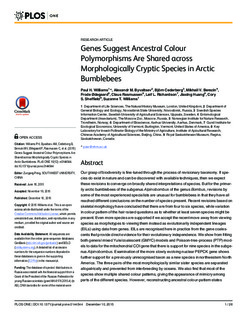| dc.description.abstract | Our grasp of biodiversity is fine-tuned through the process of revisionary taxonomy. If species
do exist in nature and can be discovered with available techniques, then we expect
these revisions to converge on broadly shared interpretations of species. But for the primarily
arctic bumblebees of the subgenus Alpinobombus of the genus Bombus, revisions by
some of the most experienced specialists are unusual for bumblebees in that they have all
reached different conclusions on the number of species present. Recent revisions based on
skeletal morphology have concluded that there are from four to six species,while variation
in colour pattern of the hair raised questions as to whether at least seven species might be
present. Even more species are supported if we accept the recent move away from viewing
species as morphotypes to viewing them instead as evolutionarily independent lineages
(EILs) using data from genes. EILs are recognised here in practice from the gene coalescents
that provide direct evidence for their evolutionary independence. We show from fitting
both general mixed Yule/coalescent (GMYC) models and Poisson-tree-process (PTP) models
to data for the mitochondrial COI gene that there is support for nine species in the subgenus
Alpinobombus. Examination of the more slowly evolving nuclear PEPCK gene shows
further support for a previously unrecognised taxon as a new species in northwestern North
America. The three pairs of the most morphologically similar sister species are separated
allopatrically and prevented from interbreeding by oceans. We also find that most of the
species show multiple shared colour patterns, giving the appearance of mimicry among
parts of the different species. However, reconstructing ancestral colour-pattern states shows that speciation is likely to have cut across widespread ancestral polymorphisms,
without or largely without convergence. In the particular case of Alpinobombus, morphological,
colour-pattern, and genetic groups show little agreement, which may help to explain the
lack of agreement among previous taxonomic revisions. | nb_NO |

